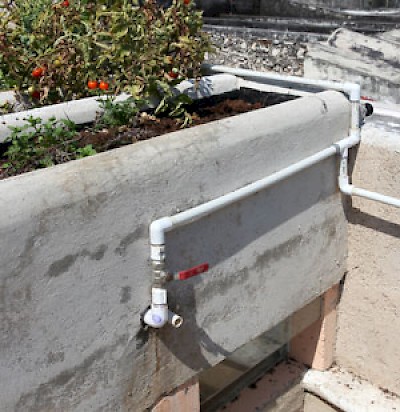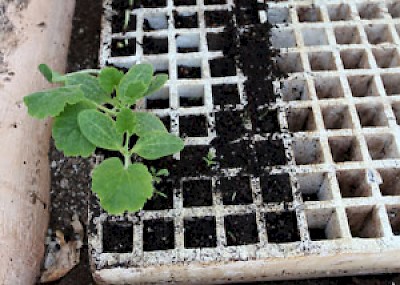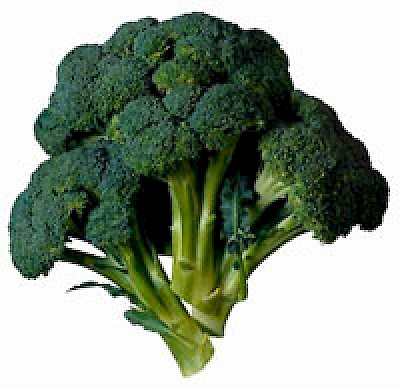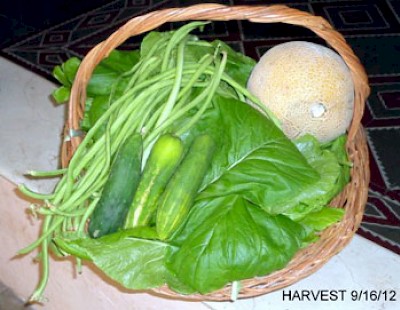Roof Gardening in Merida Part Two
Our first year of serious rooftop gardening in Merida has been one of trial and error, but also one of success and enjoyment. We have had more fresh vegetables the enjoy and share with friends than we ever would have imagined!
Timing and the Right Seeds Are Everything
Looking back, the fall, winter and spring seasons are of course the easiest and most productive. We found that we have been able to grow just about anything we wanted in these seasons. The trick is in the timing... we have had to learn to plant broccoli, for instance, so that it is ready to harvest in the coolest months (January and February), for instance. We have learned to pay attention to the season that plants are supposed to bloom and bear fruit, and to pay attention to the days between planting and harvest. Though the climate may be different here, these things are built into the seed and must be respected.
The way we do our gardening here, we must plant seeds when there are virtually no starter vegetable plants available for sale. We have learned to use only seeds that do well in warm climates. Our experience of living in South Florida has come in handy, and we try our best to use products/seeds that we know have been successful there.
Our Rooftop System
Our planting system, described earlier in this article, has worked out very well. We have taken the "work" out of gardening! By taking ideas from many people, books and internet articles and putting them together in a logical, productive and economical manner, we have created a system that works here in Merida.
The rooftop aspect of our garden solves many problems and provides many benefits:
- Having a garden on the rooftop utilizes space that would not otherwise be used.
- Our plants are up where they can get a lot of sun and we don't have to worry about interference from shade trees.
- There is no robbing of nutrients by surrounding plants and trees.
- The pests and bad insects prefer to frequent areas close to the ground.
- The sterilized soil and the proper mix results in almost no weeds.
- The raised beds (at waist height) are a lot easier to tend.
- The water supplied from below assures that the plants get just what they need and the moist soil doesn't get too hot. This fact allows us to grow vegetables right through the summer!
Planning the Garden
Mid September and October is the best time of year to get busy planting. Hopefully the planning and procurement of seeds has been done by that time.
Planning the garden is especially important if you have limited space and want multiple crops. Things to take into consideration are:
- what vegetables you enjoy growing and eating
- what space is available
- bush or vine plants, and their unique space or support needs
- light requirements
- moisture requirements
- plant compatability with other plants
- and the time between planting and harvest for each seed
Making sketches of the garden layout and how it is to be planted is very helpful. Also, once you get started, saving seeds from your garden is a good thing to do here. Its always good to create your own supply so you don't have to depend on buying them here.
Seeds in Merida
Seeds are sometimes difficult to find in Merida, especially those of the varieties we planted and loved ”back home”. The agricultural area of Merida is in the centro, around Calle 75 between Calles 52 and 54. There you will find a number of tiendas (stores) that sell seeds. By shopping around you can usually find enough variety to plant a nice garden. Many of the seeds are varieties that have been bred for cooler climates, however, so it is by trial and error that we have found the right seeds.
Look for seeds with early maturity time and plants/seeds that like warm weather. Seeds can vary widely in time from planting to time of harvest, even for the same vegetable. Fifteen or twenty days makes a big difference if you are waiting for a harvest, so pick carefully. Time spent reading seed catalogs or searching the internet for information on the different varieties of vegetables is well spent. In the 21st Century, a seed is not just a seed anymore. Seeds have been perfected in many ways, and there are many varieties available, from new hybrids to heirloom varieties. Seed swapping among gardening friends is a lot of fun and almost a necessity here in Merida.
There does not seem to be anyone growing plants for sale for home gardens in the Yucatan, so it is important to start your seeds early. Read the directions on the seed packet. Some vegetables do better started in flats or pots, while some others are good to plant directly in the garden. Always follow planting instructions on the packet because plants that get a good healthy start produce the best in the end.
Our Best Vegetables in Merida
The vegetables that have done the best for us so far are described below. We continue to experiment and try new things, of course!
Tomatoes: Everyone wants tomatoes in their garden! They are by far the favorite garden plant. In the fall, winter and spring most all of the varieties of tomatoes do well here, as they love the sun. In the summer, we have only been able to grow cherry tomatoes, as the larger varieties do not set fruit in the hot weather. Be sure to plant your tomatoes in plant mix that is sterilized. Nematodes are rampant in the soils of the Yucatan (as they were in the soils of South Florida), and they are the bane of the tomato grower. Remember that tomatoes like good ventilation, plenty of sunshine, well drained fertile soil, and frequent watering.
Corn: Sweet Corn should be at the top of the list as it has been our very favorite thing from the garden here in Yucatan. We planted Silver Queen and Golden Queen seeds and we think we are growing the best corn we have ever eaten. We had a problem with pollination, so we hand pollinated our last few crops and it works well. The corn is very happy with the same growing conditions that we have for all our plants and, of course, it loves the full sun. We have not tried growing corn for winter harvesting yet, but we will try it soon.
Lettuce: There are so many wonderful lettuces and salad mixes to choose from to make those fabulous fresh salads. Most of the greens such as mustard, turnip, beet and arugala mix beautifully to make very interesting delicious salads. By planting some greens in each bed, you do not need to plant a big area of each. Use your space to plant a small patch of each lettuce every three weeks so you always have fresh tender greens. Lettuce in the summer here can use some shade but in the cooler months the lettuce enjoys the full sun.
Eggplant: For those of us who enjoy eggplant, we are fortunate that the climate is just right here year-round to grow eggplant. The standard black eggplants do well and we have enjoyed growing white eggplants, which are milder. Oriental eggplants of various shapes make for interesting cooking and gardening as well. Most of the varieties require staking so read about the variety you are planting. Select a location with fertile, well drained soil and full sun.
Broccoli: Broccoli is a cool weather plant. To grow broccoli in the Yucatan, you must plant your seeds at a time so that you can plan your harvest in January through March for the best yields. Broccoli likes a fertile, well-drained soil and plenty of sunshine. The small heads keep coming after the first large ones and you can keep on enjoying them. The leaves are delicious when cooked like collards.
Collards: It was a great surprise for us to find that collards just keep on growing and producing right on through the hottest months here. Being from the deep south, we enjoy collards and the leaves on these plants are tender and flavorful.
Okra: We should spell 'okra' in capital letters! Again, being from the south, okra has always been a staple in our garden. Okra is like cotton – it likes hot weather. It is probably the easiest thing in the garden to grow here in Merida.
Cucumbers: Cucumbers have done well here, but not during the hottest summer months. They start growing and bearing in September, and continue to do so until June. Cucumbers are runners, so you must plan for them. We suggest constructing a trellis before you plant the seeds. Building the trellis before planting reduces the risk of damaging the root system, as you don't have to install the trellis midway through the season. Cucumbers, like most of the plants want good fertile soil, moisture and sunshine.
Cantaloupe: Flavorful cantaloupe are a real delight to have in the garden. All the same comments about cucumbers apply to cantaloupe.
Beans: So far, we have not done well with bush beans. However, we have had delicious success with the Chinese long beans. These are a conversation piece, too, as they grow to about 50cm (20”) in length. After harvesting, you can just cut them to whatever length you want and enjoy. They are tender and flavorful and have worked well in every dish we have put them in. We shared some with a friend and she ate them raw... they are that tender and tasty. The same comments used for Cantaloupe would apply to the long beans. Our seeds were given to us by a friend, and now we save our large beans for seeds.
Beets, Turnips, Onions, Scallions and Carrots: The plants on these root products looked great but the yield was disappointing. Perhaps our soil needs to be a little deeper to let the roots grow better. With a little more depth to the growing medium, we feel like they can do well, and we will be trying that in the future.
Chinese cabbage and Bok Choi: These plants do very well but not in the hottest months. Seeds we planted in early September were ready to harvest some outer leaves in late September. The same comments on lettuce and the greens apply to these. These plants grow quickly here with all the sun!
Organic?
A recent study we saw stated that organic gardening is no more nutritional than normal gardening. We are not pure organic gardeners. We adhere to many of the principles but we have found it necessary to use some non-toxic insecticides. Also, we do use some commercial fertilizers. The study also showed that the best nutrition and flavor comes from fast growth, so we have opted to improve our growth time whenever possible. Everything in the garden looks better, tastes better and is more nutritional when it has grown rapidly.
A Few Additional Comments
A few other comments that we might make from our first year experience with our Roof Top Garden System. The faster you get your produce from the plant to the plate, the better it will taste and the more nutritional it will be. Planning a garden to ripen in succession so that you can enjoy all the vegetables is an important part of getting the most nutrition out of your produce.
Your experience may be different from ours, depending on your unique garden conditions. For example, we are convinced that we can have a longer production season because of our unique watering system, where the water is provided beneath the plant medium. This keeps the plant medium moist and cooler. We have fewer bugs, animals and pests by being up on the roof and out of their natural habitat. We have almost no weeds because our plant medium is sterilized. We have no water problems because our water comes from a well on our property. We have no backache because we do not own a hoe and our planting beds are elevated. Each of these elements has added greatly to our enjoyment of the process and the outcome!
We hope that you enjoy your gardening as much. If you have questions or comments or want to explore the idea of a seed exchange, please comment below!
****
You can read the original Rooftop Gardening article, which describes the unique watering and planting system used on the roof.












Comments
mari pintkowski 12 years ago
Thank you Mari
Reply
Working Gringos 12 years ago
Mari, we suggest you contact Robert directly at rkimsey33@gmail.com.
Reply
mari pintkowski 12 years ago
Hi. We will be in Merida the nights of Feb 18 and 19. We live in Tulum Jungle and have a roof top garden the old way and have been growing for 4 years now. I am building a new building in the Summer and thought about trying it your way. Is there a possibility we could meet you and see your gardens while there?
Reply
Working Gringos 12 years ago
Actually, its Calle 75. Thanks for bringing that to our attention... we fixed it in the article.
Reply
Amy 12 years ago
Great article! Just curious about the cross streets to find seeds and plants in Centro - C. 74 X 52 Y 54? Is this correct? I am anxious to get started on my own little garden. Thanks!
Reply
Douglas Fisher 12 years ago
Interesting article. The study about organic food you mentioned should not be taken as the complete truth. It was published by Stanford University but it was paid for by a large grant from Cargil, a major producer of GMO foods. It was also published just a short period before the election in California. One of the propositions was a new law to force companies to label if the product contained any GMO's. A coincidence?? I think not.
Unfortunately the proposition did not pass so it was a big win for big agriculture and the fake study got a huge amount of press. Really sad.
Reply
« Back (10 to 16 comments)